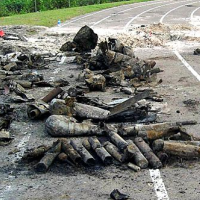U.S. Still Cleaning up Chemical Weapons from World War II…in 40 States
 World War II munitions found buried at an Orlando middle school (AP photo)
World War II munitions found buried at an Orlando middle school (AP photo)
Bring us your nerve gases, your blister agents, your horrible weapons of warfare, your wretched refuse of World War II… This about sums up the decision of leaders in Washington after World War II when it came time for the American military to dispose of its arsenal of chemical weapons and those belonging to both the countries it fought against and alongside.
After the war’s conclusion, the U.S. government buried thousands of munitions loaded with chemical agents all across the country. These weapons of mass destruction were part of the U.S. arsenal as well as those belonging to ally Britain and enemies Germany and Japan.
The bombs and containers were simply dumped in the ground and buried, without concern for long-term environmental and health consequences.
Alabama is home to the largest of 249 such sites that are located in 40 states. Redstone Arsenal, a longtime U.S. Army base, sits atop miles of hidden trenches containing blister agents, choking agents, blood agents and more.
The 38,000-acre base is surrounded by homes, schools, churches and shopping centers—a city of 200,000 people. It was reported that few residents are aware of the toxic danger lurking nearby.
A disposal team has been working at Redstone since the 1970s trying to locate all of the chemical weaponry that is buried beneath 17 six-mile-long trenches. Once those trenches have all been located, the next step—scheduled to begin in 2019—is to remove the bombs and containers with great care, due to the uncertainty of the weapons’ condition after being held deep underground for decades. No more than six munitions can be safely removed each day.
“Even if we tried to do this as fast as anybody could ever get it done, we’re talking decades and decades,” James Watson, a disposal team member, told the Los Angeles Times. “This stuff is very dangerous to dig up. It’ll hurt you. It will blister you up. If you get that nerve agent on you, it will kill you.”
Redstone’s cleanup is expected to take until at least 2042. The quantity of weapons: 388,000. Between 20,000 and 25,000 of these are intact and, once disturbed, may be volatile.
Alabama has a second site, at former Camp Sibert (pdf) near Huntsville, with at least 13 stockpiles of mustard and phosgene gas.
Another of these sites is located in Spring Valley, Virginia, not far from the White House. Its arsenal features even older chemical munitions—possibly including mustard and arsenic—manufactured during World War I.
Several years ago, a vast supply of munitions from World War II was discovered beneath the grounds of Odyssey Middle School in Orlando, Florida. One of the weapons ignited into flames, but didn’t explode, injuring an Army Corps of Engineers contractor attempting to remove it. More than 200 potentially volatile explosives were found, most under the school and some near homes in the surrounding neighborhood. Home values, which were originally in the $600,000 range, plunged by at least 30%, while banks told homeowners their residents were worthless to lend against.
The U.S. military also dumped a huge volume of chemical weapons off both the Atlantic and Pacific coasts. There are no plans to clean up those sites, although Congress has authorized studies to look into it.
In 1958, about a hundred miles offshore of California, the SS William Ralston—loaded with more than 300,000 mustard gas bombs and 1,500 one-ton containers of Lewisite, a blistering agent—was scuttled by the U.S military. To this day it sits beneath nearly 14,000 feet of water just outside of San Francisco.
Ralston believes the U.S. task of removing 1,300 tons of secured chemical weapons from Syria for destruction at sea will be something of a breeze compared to the job here at home. “In Syria, you know where the weapons are and what they are, and they can move them with a forklift,” Watson told the Times. “Here, we don’t know. We have to go out there and dig them out of the ground … The sheer mass of this stuff is overwhelming.”
-Noel Brinkerhoff, Danny Biederman
To Learn More:
Deadly Chemical Weapons, Buried and Lost, Lurk Under U.S. Soil (by David Zucchino, Los Angeles Times)
Redstone Arsenal: Yesterday and Today (by Michael Baker, U.S. Army Missile Command)
A Generation of Indiscriminate Dumping (Daily Press) (pdf)
- Top Stories
- Unusual News
- Where is the Money Going?
- Controversies
- U.S. and the World
- Appointments and Resignations
- Latest News
- Trump to Stop Deportations If…
- Trump Denounces World Series
- What If China Invaded the United States?
- Donald Trump Has a Mental Health Problem and It Has a Name
- Trump Goes on Renaming Frenzy






Comments